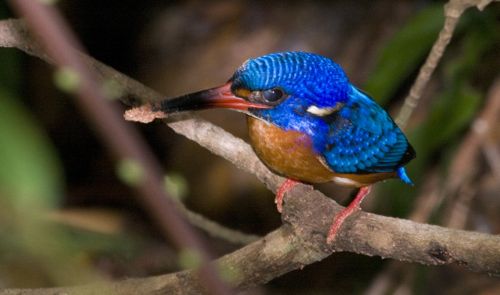“The Blue-eared Kingfisher (Alcedo meninting) is a rare resident in local reserves. Considered nationally endangered with an estimated population of 10 (Wang & Hails, 2007), this bird does not frequent gardens, parks or disturbed areas, unlike its close relative, the migrant Common Kingfisher (Alcedo atthis), which can be seen at spots like the Botanic Gardens, Japanese Garden and well-vegetated waterways during the winter months. In Malaysia, however, the Blue-eared Kingfisher is known to be less secretive, with Madoc (1947) recording that it can “be met on the fringes of the jungle, in [rubber?] estates and even on the roadside.”
“The appearance of the blue-eared kingfisher is similar to its commoner cousin, but the plumage is markedly more saturated, with a deeper blue upperside and stronger shade of orange-rufous on the underparts. The male (the local subspecies A. m. veerauxii) has a blackish bill and blue ear-coverts (the part of the head just behind the eye) which make the head and back particularly striking. The female has a reddish bill and rufous eye-coverts.
“Confirmed breeding records in Singapore are not known to date. Robson (2000) notes that the species nests in excavated banks or termite mounds. Madoc has observed nest tunnels in roadside banks and “even in the side of a contour drain on a hilly rubber estate.”
“Local birders has a rare encounter earlier this year when a pair of Blue-eared Kingfishers took up residence at a stream bank in the Central Catchment Nature Reserves. The site was very close to the walkway and thus afforded good views of the birds. I came across the pair one afternoon and spent about 15 minutes observing them. Each bird would emerge from an embankment (that could not be seen from the walkway) and perch on a low branch. Earth was evident on the tips of the bill. After resting for a couple of minutes, it would head back, presumably to its tunneling. The mate would then take its turn on the branch. It seems the digging duties are shared by both sexes.
“It was reported that this nesting failed. Whether it was due to natural events (ground-dwelling snakes are not uncommon in the area) or human disturbance (as the area is frequented by joggers, sundry nature lovers and photographers both day and night) is unclear.”
Marcus Ng
The Annotated Budak
11th May 2009
References:
1. Madoc, G. C. (1956). An introduction to Malayan birds. Malayan Nature Society, Kuala Lumpur. (revised ed.)
2. Robson, C., 2000. A field guide to the birds of South-east Asia. New Holland, London.
3. Wang, L.K. & C. J. Hails, 2007. An annotated checklist of birds of Si ngapore. Raffles Bulletin of Zoology, Supplement 15: 1-179.










4 Responses
Hi, this bird visited my home today and has been doing so for last one week it has been feeding on my neon guppies which is in a small lotus planted pot for mosquito control purpose. It decided to stay over for the night clinging on the railing of my apartment balcony, my location is Flora Drive near loyang ave, sgp. Must be small population in the east side .
If you happen to have a photograph or two, we can make an interesting post here.
Sorry Alienor, no image received.